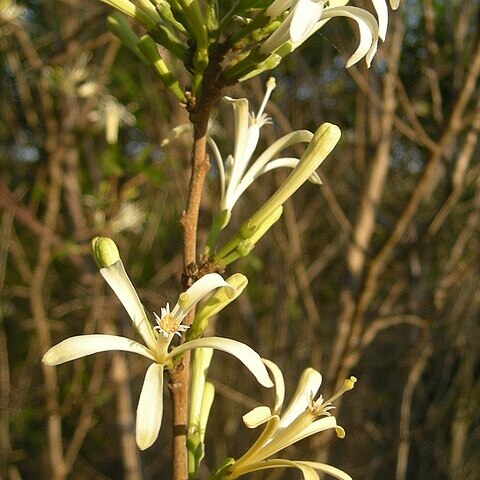Small trees or shrubs. Indumentum of simple hairs. Leaves simple (pinnate in one African species), entire or (not in Malesia) sometimes sinuate or crenate. Inflorescences axillary, fasciculate, cymose or paniculate, or flowers solitary (terminal or ramiflorous outside Malesia). Flowers bisexual, greenish or white. Calyx (3–)4–5(–6)-lobed or-toothed. Petals (3) 4 or 5, free, imbricate or contorted. Staminal tube cylindrical or rarely (not in Malesia) cyathiform, complete or filaments at least 2/3 united; margin shallowly lobed or entire (not in Malesia) or terminated by simple or bilobed appendages, as many as or twice as many as the anthers; anthers (7–)8–10(–20). Disk small or absent. Ovary (3–)4–10(–20)-locular; locules biovulate; style usually expanded near apex forming a ‘receptaculum pollinis’ surmounted by a discoid stigmatic area. Fruit a (3–)4–10(–20)-valved, loculicidal capsule; locules 1-or 2-seeded. Seeds plano-convex, raphe-funicular-arillate; embryo embedded in thick endosperm, with rather narrow cotyledons.
Trees or shrubs. Leaves alternate, usually simple, petiolate; leaf blade margin entire or sometimes crenate. Flowers bisexual, axillary, solitary or sometimes forming racemes or corymbs. Calyx cup-shaped or campanulate, short, 4-or 5-lobed. Petals 4 or 5, distinct, linear to spatulate, much longer than sepals, imbricate or contorted in bud. Staminal tube cylindric, long, thin, apex inflated and lobed; anthers 8-10(-20), inserted between lobes, included or ± exserted. Disk annular or absent. Ovary subglobose to elliptic, small, glabrous, 4-locular or more, with 2 anatropous ovules per locule; style filiform, exserted from tube; stigma disciform, capitate, or ampuliform. Fruit a loculicidal capsule, 4-locular or more, with 1 or 2 seeds per locule; pericarp leathery or woody. Seeds oblong to ellipsoid, ± curved, smooth, with one broad and compound hilum; endosperm fleshy; cotyledons leaflike; radicle cylindric.
Trees or shrubs with simple hairs. Leaves (in Australia) simple, entire. Flowers bisexual, in cymes or fascicles or solitary-axillary. Calyx usually 4-or 5-toothed or-lobed. Petals usually 4 or 5, free, imbricate or contorted. Staminal tube entire or tipped with free filaments to ½ its length; margin often with simple or bilobed appendages; anthers usually 8–10, apical. Disc small or absent. Ovary usually 4–10-locular; locules biovulate; style usually expanded near apex, forming a pollen receptacle surmounted by discoid stigmatic region. Capsule loculicidally dehiscent, usually with 4–10 valves and 1-or 2-seeded locules. Seeds plano-convex with raphe-funicular arils.
Style elongate, distally expanded to form an ovoid, globose, cylindric or conical style-head of which the proximal part serves as a receptaculum pollinis and the distal part forms a disk-or cushion-shaped stigmatic surface.
Staminal tube cylindric, sometimes expanded distally, terminated by simple or 2-lobed free or partly or completely fused appendages opposite to or alternating with the anthers.
Anthers (8) 10 (20), apiculate, inserted on the rim of the staminal tube or inside the tube towards the apex, sessile or with short filaments.
Disk always present (in our area), sometimes vestigial, partly or completely fused to the base of the staminal tube.
Ovary small, with (4) 5–10 (20) loculi, each with 2 anatropous or almost campylotropous superposed ovules.
Calyx cupuliform, with (4) 5 (6) teeth or lobes, sometimes almost entire-margined, persistent in fruit.
Flowers bisexual, solitary or fasciculate or in axillary or terminal cymes or false racemes.
Leaves simple, alternate, sometimes fasciculate, usually entire, rarely shallowly lobed.
Seeds large, with a large or small, orange or red aril; testa black or red, shining.
Fruit a small leathery or woody loculicidal capsule with (4) 5–10 (20) valves.
Petals (4) 5, much longer than the calyx, linear-spathulate to linear.
Shrubs or small trees, sometimes scrambling.

